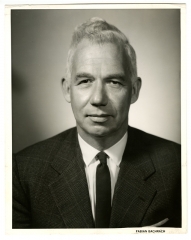meeting of the Board each year would be open to faculty and students who might wish to discuss any matter with the Trustees and that faculty and students should be seated on all standing committees of the Board except the Executive Committee. Meanwhile, the faculty had voted that there be student members on all faculty committees except the Curriculum Committee.
By the fall of 1967, some months prior to the sit-in and its consequences, Dr. Barnett had come to the conclusion that the presidency of an American college could no longer provide the personal satisfaction he had hoped for, such as opportunities for teaching, scholarly pursuits, and professional consulting work. He had intended to announce his retirement in June, 1968, effective a year later, when the University would be entering a new cycle of planning, he informed the campus community. Subsequent campus developments, however, convinced him that a review of University policies and structures was so urgent that his successor should be found promptly so that he might participate in this examination. Furthermore, the endowed professorship which he had accepted had become available a year earlier than he had anticipated. These were the circumstances which prompted him to advance his retirement date to February 1, 1969. During his tenure Colgate made notable advances in teaching, physical plant, and financial resources and his efforts for a greater Colgate won him esteem and gratitude.
The changes of the 1960’s reflect the unrest and concern to be found quite generally throughout American colleges as well as on the Colgate campus. On the eve of the 125th anniversary, James C. Colgate sent a message to the alumni which has relevance for all who support the University on its 150th birthday. He wrote:
We have a grand past to celebrate. This is one asset which cannot be taken away. It is ours.
As to the future I have no anxiety. With such a history we cannot be on a dead end street . . . [All] will not be unanimous in their views but will be united in their efforts and a greater Colgate will result.
‘Faith of our fathers, holy faith,
We will be true to thee till death.’







